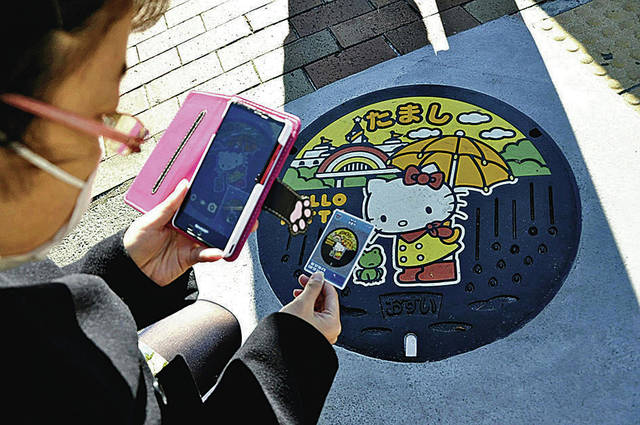Japanese cities attracting tourists with manhole cards

JAPAN NEWS / YOMIURI
A visitor photographs a manhole cover featuring Hello Kitty in the Tama area of Tokyo, after getting a manhole card of the hatch.
TOKYO >>
A total of 1.4 million manhole cards, featuring pictures of manhole covers with unique local designs, have been issued since the cards were launched in April 2016, a group promoting the appeal of manholes has said.
The free cards have gradually gained popularity with collectors because each type is only available in the municipality where the manhole covers are shown.
With the release of the sixth series of cards in December, there are now cards for municipalities in all prefectures. Local governments are promoting them to attract card collectors for regional sightseeing.
Such was the case of a 59-year-old company employee who lives in Yokohama and visited the Nagayama Kominkan public hall in Tama, Tokyo, on Dec. 9. That’s where he received a card of a local manhole cover featuring the popular character Hello Kitty.
He smiled and said, “After I began collecting manhole cards, I started looking down at the ground when I was walking along the street.”
Don't miss out on what's happening!
Stay in touch with breaking news, as it happens, conveniently in your email inbox. It's FREE!
Because there is a Sanrio Puroland amusement park in Tama, the city government adopted the Sanrio brand’s Kitty character for two kinds of its manhole cards — the sewer and rainwater drain versions — and printed 10,000 cards for each version.
According to the city, 1,961 cards were distributed in the first four days through Dec. 12, with 65 percent of the recipients flocking from other municipalities.
An official of Tama’s sewage division said: “It’s a good start. The results are better than we expected.”
Drawing visitors
After getting a card, many people actually visit the places where the hatch is placed.
On the remote island of Ikinoshima — an hour’s ride by speedboat from Hakata Port in Fukuoka — the Iki city government joined the sixth series, issuing cards of a manhole cover featuring a traditional ogre-shaped kite called ondako. From Dec. 9 through Dec. 12, about 100 people visited the island to get the cards, including visitors from as far away as Shiga Prefecture and Hokkaido.
The city government and other entities will organize in spring an overnight tour allowing participants to visit local manhole covers and an island sightseeing spot called Saruiwa, a rock formation shaped like a monkey.
In April 2016, the first series of manhole cards from 28 municipalities were released and 100,000 cards were issued.
The Hiroshima municipal government began issuing cards of a manhole cover depicting Carp Boya — the boy mascot character of the Hiroshima Carp baseball team. For people who want to collect the card, the city has set a requirement that applicants visit a rainwater reservoir facility in the basement of Mazda Zoom-Zoom Stadium in the city beforehand. As a result, the number of visitors to the facility in 2016 surged to 1,616, nearly triple the figure from the previous year.
The municipal government of Maebashi issued its version of manhole cards in December 2016. As a further promotion, the city put 10 used steel manhole covers on sale in August and September last year. The 88-pound metal disks, 23 inches in diameter, sold for $28 each.
An official of the city’s waterworks bureau said, “Before the sale started, I was wondering if there was anybody who would want to buy them.”
The results were surprising to the official, as they received 193 applications from all over the country. There were 41 applications for the most popular cover. The city government is considering selling more manhole covers.
Commenting on the trend, Tokai University Prof. Takayoshi Kawai said publicizing local attractions through manhole cards “is less expensive than using yurukyara mascot characters and promotional videos. It’s a highly cost-effective means (of regional promotion) for local governments as the cards also can draw collectors to their regions.”
How it all started
The manhole card project was launched by a group called Gesuido Koho Platform — a sewerage publicity organization of the Land, Infrastructure, Transport and Tourism Ministry, an association of the sewerage industry and other organizations. On the front of each card, a photo of a manhole cover is printed with the longitude and latitude of its location, with an explanation of the background of the design written on the back of the card.
Each of the cards — which measure 2.5 by 3.5 inches — has a serial number in order to appeal to collectors, an official said.
The cost of issuing the cards — $320 per 2,000 cards — is paid by local government. The publicity group said the cards’ increasing popularity has exceeded the printing capacity.




